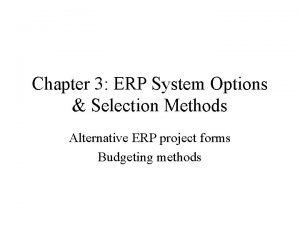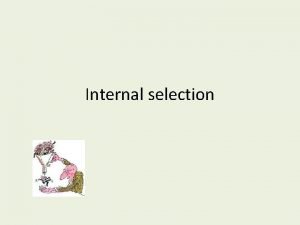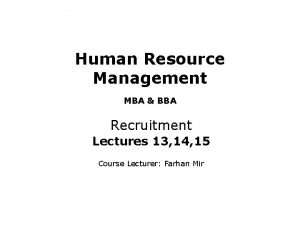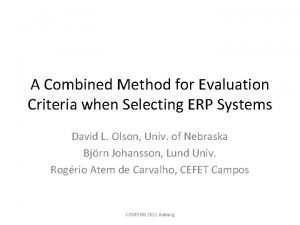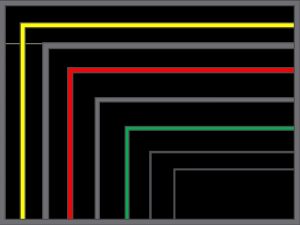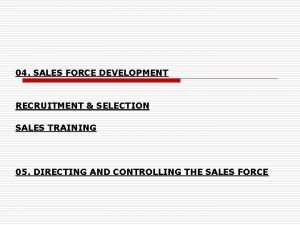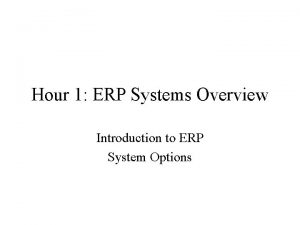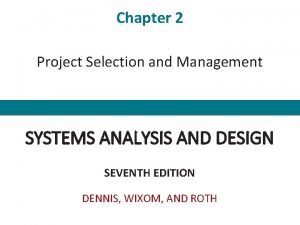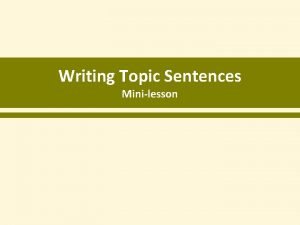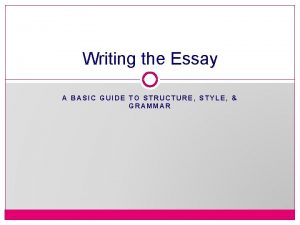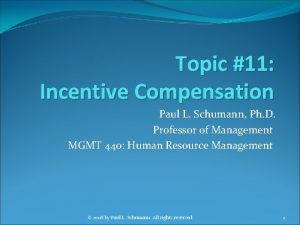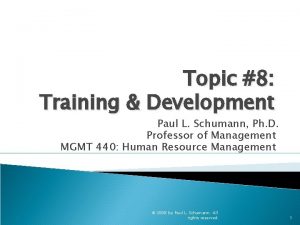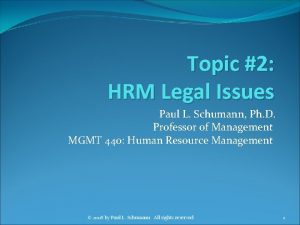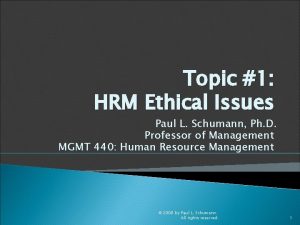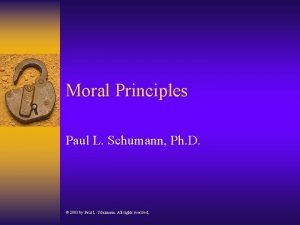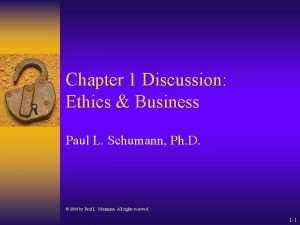Topic 6 Selection Methods Paul L Schumann Ph







































- Slides: 39

Topic #6: Selection Methods Paul L. Schumann, Ph. D. Professor of Management MGMT 440: Human Resource Management © 2008 by Paul L. Schumann. All rights reserved. 1

Outline � Quick Review of Selection Theory � Selection Methods � Application Blanks & Résumés � Employment Interviews � Reference Checks � Medical Examinations � Drug Tests � Credit Reports � Work Sample Tests � Trainability Tests � Assessment Centers � Personality Inventories � Honesty & Integrity Tests � Cognitive Ability Tests � Other Ability Tests � Biodata Questionnaires � Experience & Accomplishments Questionnaires � Criteria for Choosing Selection Methods 2

Selection Process Step 1 - Measurement: Measure each applicant’s qualifications using the selection methods Step 2 - Decision Making: Use the qualifications to predict job performance to decide which applicant to hire Step 3 - Evaluation: Evaluate the selection process Source of figure: Fisher, Schoenfeldt, & Shaw (2006), Figure 7. 1, p. 283 3

Selection Process �Selection methods measure the applicant’s qualifications for the job �We use the selection methods to predict the job performance of each applicant �For each selection method (know for quiz): �Describe the selection method �Rate the validity of the selection method — how well does the selection method predict job performance: Poor: validity coefficient = r ≈. 00 � Moderate: validity coefficient = r ≈. 25 � Good: validity coefficient = r ≈. 50 � Great: validity coefficient = r ≈. 75 � 4

Taylor-Russell Table Poor Moderate Good Great Get better hires by: Increasing the Base Rate of Success (BRS) by effective recruiting Increasing validity (r) by using selection methods with good (. 50) or great (. 75) validity Decreasing the Selection Ratio (SR) by raising the selection cutoff score Source of table: Fisher, Schoenfeldt, & Shaw (2006), Table 7. 2, p. 307. 5

Résumés & Application Blanks �Purpose: collect basic factual information about the applicant �Name, address, phone, e-mail, education, work history, training, skills, accomplishments, etc. �Use: screen out applicants who don’t meet the job’s minimum qualifications in terms of education, work experience, etc. �Validity as typically used: poor (typically r <. 20) �Why? Lack of agreement on what to look for 6

Résumés & Application Blanks �Solution to poor validity: be structured in how you evaluate the résumés or application blanks �Use a numerical scoring system to evaluate the résumés � Define in advance of evaluating the résumés what keywords are associated with each of the job’s essential qualifications � Example: What words on a résumé indicate a college degree? � Develop a rating system to numerically rate the keywords � Example: How many points out of 100 is a college degree worth? � Example: Does it matter which university? MSU vs. Uof. M? � Conduct a validity study of the rating system (concurrent? ) � If valid, use it; otherwise, revise it �Validity: good (typically r ≈. 50) if properly done 7

Résumés & Application Blanks By switching from the typical unstructured résumé evaluation to a structured résumé evaluation, we increase the validity of our evaluation of applicants’ résumés from poor (. 00) to good (. 50) Fisher, Schoenfeldt, & Shaw (2006), Figure 8. 2, p. 324: describes the steps in constructing a Weighted Application Blank (WAB) 8

Employment Interviews �Validity as typically done: poor (r <. 20) �Why? Typical interviews are unstructured �Types of Interviews (Degree of Interview Structure) �Unstructured: few (if any) pre-planned questions; commonly used; poor validity (so don’t use this type of interview) �Semi-structured: some pre-planned questions, but with lots of flexibility to pursue lots of follow-up questions; moderate validity (don’t use it because we can do better) �Structured: all questions are pre-planned; every applicant gets the same questions; some limited follow-up questions allowed; answers evaluated by numeric rating scales; good validity (this type of interview is a key to good hires) 9

Employment Interviews �Types of Structured Interviews �Patterned Interview: ask about education, work experiences, career goals, etc. � Example questions: � Why did you pick your major? � What are your strengths and weaknesses? � What do you plan on doing 5 years from now? � Validity: moderate (we can do better than this) � Having an interview “script” helps validity � Every applicant gets exactly the same questions � But the typical questions may not be all that helpful � What’s a good answer to “Why did you pick your major? ” 10

Employment Interviews �Types of Structured Interviews (more) �Situational Interview � 3 types of questions: � Hypothetical: questions that describe a situation and ask what the applicant would do in that situation � Job-Knowledge: questions that ask applicants to define jobrelated terms, or explain a procedure, or demonstrate a skill � Job Requirements: questions that ask applicants about their willingness to comply with job requirements (e. g. , travel, shiftwork, etc. ) � Each question has a scoring system to rate the applicant’s answers on numerical rating scales � To improve validity, use a panel of interviewers to evaluate each applicant’s interview � Validity: good (we might be able to do better than this) 11

Employment Interviews �Types of Structured Interviews (more) �Behavioral Interview (Behavior Description Interview) � Questions ask applicants for specific examples from their past experiences of specific job-related issues � Commonly used question format: “Tell me about a time when …. ” � Examples: � For a sales position: “Tell me about your most difficult recent sale. What did you do? What happened? ” � If team leadership is essential to the job: “Tell me about a time when you were the leader of a team. What did you do? What happened? ” � If providing effective performance feedback is essential to the job: “Tell me about a time when you had to talk with a person about their poor performance. What did you do? What happened? ” 12

Employment Interviews �Types of Structured Interviews (more) �Behavioral Interview (more) � Each question has a scoring system to rate the applicant’s answers on numerical rating scales � Use rubrics: For each question, write an example of what would be the: � Best answer (e. g. , best answer = 5 points) � Good answer (e. g. , good answer = 3 points) � Bad answer (e. g. , bad answer = 1 point) � To improve validity, use a panel of interviewers to evaluate each applicant’s interview � Validity: good to great (r >. 60, if properly done); this is usually our best choice of interview formats 13

Employment Interviews By switching from the typical unstructured interview to a highly structured behavioral interview, we increase the validity of the interview from poor (. 00) to good (. 50) or even great (. 75) If properly done (that’s the catch), this can be one of our best selection tools But if we conduct the usual unstructured interview, it’s little better than pulling names out of a hat 14

Reference Checks �You should always carefully check the references of the finalists for the job before making a job offer �Include the applicant’s former supervisors �Validity: moderate (r ≈. 25), but do careful and thorough reference checks anyway to reduce chances of lawsuits for: �Negligent hiring: organization can have legal liability if it failed to check references and it hires a person with a history of workplace violence who then repeats the workplace violence 15

Reference Checks �But, some managers are reluctant to provide negative information about a former employee in a reference check �They may only want to provide limited information such as the dates of employment and job title of the former employee � Why? They think that by giving only the limited information that they can avoid lawsuits for: � Defamation of character: if you provide negative information about your former employee, he or she might sue you 16

Reference Checks �But the former employee might still sue for defamation by arguing that limited information is negative information �And only providing limited information about a former employee in a reference check also runs a risk of a lawsuit for: � Negligent misrepresentation (negligent referral): if you fail to provide accurate and relevant negative information about a former employee in a reference check, the former employee’s new employer might sue you for not being truthful about your former employee, especially if the employee was violent 17

Reference Checks �Some states have passed laws designed to protect employers from defamation of character lawsuits when they give reference information �Example: Minnesota Statue 181. 967 on Employment References (effective 8/1/04) � https: //www. revisor. leg. state. mn. us/statutes/? id=181. 967 �My recommendations: �Always do careful reference checks when hiring �When you (as a manager) get called about a reference check concerning a former employee: Follow the organization’s policies on providing reference information � Provide accurate information that you can document � 18

Medical Examinations �A medical doctor performs a medical exam of the applicant �Americans with Disabilities Act (ADA): only use a medical exam after making a job offer that is conditional on passing the medical exam; can use results of the medical exam to: Revoke the conditional job offer if the applicant is found to be physically unable to perform essential job duties with reasonable accommodations � Assign applicants to jobs (e. g. , bronchitis) � Prevent the spread of contagious diseases � Document pre-existing injuries & illnesses to prevent fraudulent insurance claims � �Validity: poor (with overall job performance), but still might be used for the above reasons or for drug tests 19

Drug Tests �Used in the following situations: �Part of the pre-employment medical exam �Part of an investigation of current employees �Random drug tests of current employees �Caution: Even very reliable drug tests can have a surprising high false accusation rate �Why? Most people are innocent, and a small error rate applied to lots of innocent people can generate lots of false accusations � So, consider re-testing those who test positive before taking action against them (especially for current employees) 20

Credit Reports �Fair Credit Reporting Act: �Credit reports can be used as a selection method, but only if the following conditions are satisfied: Applicant has been notified in a clear and conspicuous written disclosure � Applicant gives written authorization � Information is not used in violation of employment discrimination laws � Monitor for adverse impact discrimination � Be ready to demonstrate job-relatedness or business necessity � Example: position involves the handling of money � �My advice to job seekers: Check your 3 credit reports before you begin looking for a job and correct any errors: �https: //www. annualcreditreport. com 21

Work Sample Tests �In a standardized format, have applicants perform the tasks required by the job (all or some) �Examples: � For a sales job, have applicants make a simulated sales pitch � For a construction job, have applicants interpret blueprints � For a teaching job, have applicants teach a class � For a secretarial job, have applicants type letters, reports, etc. �Validity: typically good (r ≈. 50 [. 45 or. 54]) �Assuming, of course, that the work sample correctly captures the job’s essential tasks 22

Trainability Tests �Typically used for semi-skilled jobs when the applicant is not expected to know the skills involved in the job �Applicant is instructed how to perform the tasks �Applicant performs the tasks once or twice with coaching �Applicant then performs the tasks without coaching � Applicant is observed and performance is evaluated for errors �Validity: typically moderate 23

Assessment Centers �Work sample test for manager positions �Measure: leadership, communication, decisiveness, organizing & planning, etc. �Examples of assessment techniques: � In-basket exercises � Leaderless group discussions � Oral presentations � Role-playing exercises �Applicants are observed & evaluated by multiple trained observers �Validity: good, but expensive 24

Personality Inventories �Myers-Briggs Type Indicator (MBTI) �Validity: poor for selection purposes � Might be okay, if carefully used, to help a team work better together �Many psychologists who study personality today prefer a different measure of personality than the MBTI: � Big 5 Dimensions of Personality 25

Personality Inventories �The Big 5 Personality Dimensions: “OCEAN” �Openness: curious, imaginative, variety of experiences �Conscientiousness: prudent, organized, thoughtful �Extraversion: sociable, outgoing �Agreeableness: cooperative, sympathetic, kind �Neuroticism: easy to anger, anxiety, depression � Sometimes reverse-scored to get opposite of neuroticism: � Adjustment: stable, calm, stress-tolerant �Example questions for each dimension: http: //en. wikipedia. org/wiki/Big_Five_personality_traits 26

Personality Inventories �The Big 5 Personality Dimensions (more) �Example: California Personality Inventory (CPI) from CPP (formerly known as Consulting Psychologists Press) �Validity: typically moderate for selection (r ≈. 25 with measures of overall job performance) � But, validity of the Big 5 is hard to generalize � Some dimensions of personality may correlate more strongly with particular aspects of particular jobs � Extraversion: success in sales � Low agreeableness, low conscientiousness, & low adjustment (high neuroticism): more likely to engage in counterproductive work behaviors (e. g. , break rules, abuse sick leave, drug abuse, workplace violence, etc. ) 27

Personality Inventories �Minnesota Multiphasic Personality Inventory (MMPI) �Designed to diagnose mental health issues � MMPI-2 has almost 600 questions (true/false/can’t say) � I am good at meeting other people � Sometimes evil spirits control my actions � Dimensions (scales) include: Hypochondriasis, Depression, Hysteria, Psychopathic Deviate, Masculinity-Femininity, Paranoia, Psychasthenia, Schizophrenia, Hypomania, & Social Introversion �Controversial to use for selection purposes �Validity for selection purposes is hard to summarize 28

Honesty & Integrity Tests �Employee Polygraph Act (1988) prohibits (with some exceptions) the use of polygraph tests of applicants or employees �Polygraphs of applicants were then replaced by paperand-pencil honesty & integrity tests � 2 types of paper-and-pencil integrity tests: � Overt integrity tests � Personality-oriented integrity tests 29

Honesty & Integrity Tests �Overt integrity tests: measures attitudes about dishonest behavior �Example: “Everyone will steal if given the chance” �Tools: � Pearson Reid London House: � Personnel Selection Inventory � Reid Report Assessment � Secure Point: � Stanton Survey �Validity: good (r ≈. 55) 30

Honesty & Integrity Tests �Personality-oriented integrity tests: measures personality traits associated with integrity: dependability & conscientiousness �Tools (usually based on the CPI): � Hogan Assessments: Hogan Personality Inventory has a “Organizational Delinquency” scale � Personnel Decisions International (PDI): PDI Employment Inventory has an “Employee Deviance” scale � CPP: Personnel Reaction Blank has a “Wayward Impulse” scale �Validity: moderate (r ≈. 27) 31

Cognitive Ability Tests �Also called mental ability tests or intelligence tests �Tools: �Wechsler Adult Intelligence Scale (full) �Wonderlic Personnel Test (quick: 12 minutes) �Validity: good to great (typically r >. 40, e. g. , r ≈. 51, some as high as. 80) �Furthermore, the good-to-great validity can be generalized across a wide variety of jobs �Problem: adverse impact �So, debate about their use: they work, but you risk adverse impact discrimination 32

Other Ability Tests �There are lots of tests of a variety of abilities �Examples: � Bennett Mechanical Comprehension Test: test of mechanical abilities � Wonderlic Basic Skills Test: test of basic verbal & math skills � HAY Aptitude Test Battery: test of speed & accuracy with alphanumeric data �Validity: typically good, if the tested ability is really job-relevant 33

Biodata Questionnaires �Standardized questionnaire about an applicant’s life experiences �Example questions: � Did you ever build a model airplane that flew? � When you were a child, did you collect stamps? � Do you ever repair mechanical things in your home? �Answers are scored using a scoring key �Validity: moderate (r ≈. 30 or. 35) 34

Experience & Accomplishments Questionnaires �Questionnaire focuses on an applicant’s job-related experiences & accomplishments �To make the questions job-related, the questionnaire is usually customized to fit job categories � Example: For an Information Systems Analyst position: � Describe the types of IT systems problems you have encountered � Describe the types of manual processes you have studied to develop automation recommendations � Describe your experiences in testing hardware, software, or systems �Validity: moderate (typically content validity) 35

Criteria for Choosing Selection Methods �Validity: how well does it predict job performance? �Utility: factors to consider in addition to validity: �Cost, base rate of success, standard deviation of performance (in dollars), & selection ratio �Legality & likelihood of legal challenge �Acceptability to managers �Applicant reactions �Societal impact 36

Taylor-Russell Table Get better hires by: Increasing the Base Rate of Success (BRS) by effective recruiting Increasing validity (r) by using selection methods with good (. 50) or great (. 75) validity Decreasing the Selection Ratio (SR) by raising the selection cutoff score Source of table: Fisher, Schoenfeldt, & Shaw (2006), Table 7. 2, p. 307. 37

Summary & My Advice � Core selection procedures — almost always use: � Structured résumé evaluation or weighted application blank (good validity) � Structured behavioral interview (good to great validity) � Reference checks (moderate validity, but do it to avoid negligent hiring) � Consider adding: � Work sample test (good validity) � Cognitive ability test (good to great validity, but monitor for adverse impact discrimination) � For some jobs, consider adding: � Medical exam with drug test (poor validity for predicting job performance, but might be useful for other reasons) � Overt integrity test (good validity) � Other selection methods as appropriate 38

Outline � Quick Review of Selection Theory � Selection Methods � Application Blanks & Résumés � Employment Interviews � Reference Checks � Medical Examinations � Drug Tests � Credit Reports � Work Sample Tests � Trainability Tests � Assessment Centers � Personality Inventories � Honesty & Integrity Tests � Cognitive Ability Tests � Other Ability Tests � Biodata Questionnaires � Experience & Accomplishments Questionnaires � Criteria for Choosing Selection Methods 39
 La follia tesina 3 media
La follia tesina 3 media Robert schumann dela
Robert schumann dela Edward schuman
Edward schuman Heinz schumann
Heinz schumann Vurdering af kvalitative studier
Vurdering af kvalitative studier Resonancia schumann en vivo
Resonancia schumann en vivo Elke schumann management
Elke schumann management Astecas
Astecas Fla vs sla
Fla vs sla Igs robert schumann frankenthal
Igs robert schumann frankenthal University of education weingarten
University of education weingarten Ressonância schumann hoje
Ressonância schumann hoje Clincher sentence
Clincher sentence Topic down
Topic down Ib group dynamics
Ib group dynamics Wax pattern fabrication pdf
Wax pattern fabrication pdf Erp selection methods and criteria
Erp selection methods and criteria Selection
Selection Selection methods in hrm
Selection methods in hrm Software evaluation criteria
Software evaluation criteria The steps involved in portfolio selection
The steps involved in portfolio selection Approaches of cooperative learning
Approaches of cooperative learning Recruitment and selection of sales force ppt
Recruitment and selection of sales force ppt Introduction to erp systems
Introduction to erp systems Selection project 2
Selection project 2 Balancing selection vs stabilizing selection
Balancing selection vs stabilizing selection Similarities
Similarities K selection r selection
K selection r selection Natural selection vs artificial selection
Natural selection vs artificial selection Difference between continuous and discontinuous variation
Difference between continuous and discontinuous variation Stabilizing selection human birth weight
Stabilizing selection human birth weight Clumped dispersion
Clumped dispersion Natural selection vs artificial selection
Natural selection vs artificial selection Two way selection and multiway selection in c
Two way selection and multiway selection in c Two way selection and multiway selection in c
Two way selection and multiway selection in c Mass selection
Mass selection What is the topic sentence
What is the topic sentence Topic sentence about train system
Topic sentence about train system Sexy writing structure
Sexy writing structure Expository paragraph format
Expository paragraph format
















